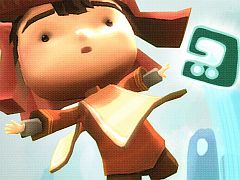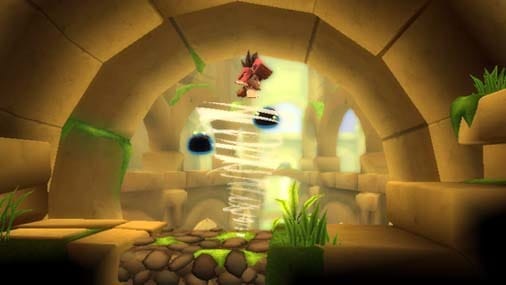You can trust VideoGamer. Our team of gaming experts spend hours testing and reviewing the latest games, to ensure you're reading the most comprehensive guide possible. Rest assured, all imagery and advice is unique and original. Check out how we test and review games here
The opening sentence of Tom’s LostWinds review described the game as “without doubt the premier WiiWare title currently available on Nintendo’s new service”. He was right, although such lofty praise may now have to be rethought. That’s because UK developer Frontier is about to release the game’s sequel, Winter of the Melodias, a title I had the pleasure of playing this week at a Nintendo press event.
Although plot wasn’t the main draw of the first game, Frontier intends to further explore the pages upon pages of LostWinds lore it’s already created with a better and more involved story. The adventure picks up only a few weeks after the first game. Toku and Enril the Wind Spirit are in search of his long lost mother, Magdi. As they approach Summerfalls Village they discover it’s gripped in a bitter winter that seems to know no end and locals scarred stiff by the appearance of monsters. Don’t tell anyone, but we’d say it’s a good bet that ultimate LostWinds bad guy, Balasar, might have something to do with it. Expect character and plot development to feature more heavily this time around, and the appearance of cutscenes.
Winter of the Melodias builds upon all that was great about the original – the tight, pixel perfect side scrolling platforming, the Wii Remote-controlled wind, the gorgeous, enchanting graphics and the engaging puzzles – but it also adds a number of new features to the mix that should ensure an all-round bigger and more varied game.
Chief of these is the winter itself. In Winter of the Melodias, Sonté Spirit of Seasons grants Toku the power to instantly transform Mistralis between summer and winter. This has a number of gameplay effects. At its most basic winter will turn water into ice, creating platforms you’re able to stand on, or, vice versa turn ice into water, creating a swimming pool our hero Toku can dive into and explore for hidden items.
Dive into? What? Toku can‘t swim! Easy there tiger. In Winter of the Melodias Toku can swim. It’s one of his new tricks, in fact. He can’t swim forever of course – he’ll eventually run out of air – but that’s okay, because holding down the B button on the Wii Remote and drawing a slip stream through the water will carry Toku along like a turtle riding an ocean current to Australia.
Developer Frontier has used this summer/winter dynamic to create platforming puzzles more complex than before. In one section I was faced with two holes in the ground, one filled with ice. The solution involved switching from winter to summer and back again. First, I switched to summer, turning the ice into water. Then I created a cyclone, another new ability, by circling the nunckuck. This cyclone sucked up the water, creating a cloud. I then used a gush of wind to send the cloud to the left, leaving it hovering above the second hole in the ground. Then, with a downward thrust of wind, the cloud rained, filling the hole with water. A quick switch to winter turned the water into ice. That’s how you get ice from one hole into another, and is evidence that Frontier’s claim that the game will be the first to incorporate a weather system into gameplay isn’t a false one.
When in winter, snowballs can be created by quickly drawing a circle. These then fall to earth, pushing down time-based switches – one of the classic platform game puzzles. As before, using the wind to send fire from torches burns down vines that block your way, but ice barriers can be destroyed in the same way. Clearly, the potential is for a much more varied game this time around, with scope for more complex, elaborate puzzles with perhaps more than one solution. Those who criticised the first game for being too easy and short should be pleased by this.
Switching seasons isn’t only used to solve puzzles, it can help Toku defeat enemies. New are the blue and red glorbs. Blues can be frozen with a quick left to right and back again flick of the Wii Remote, and then destroyed with a downward gush of wind. Reds are vulnerable to water. The cyclone power can be used to send Toku spiralling up into the air, defeat enemies and drill into rock.
Little Toku isn’t immune to the freezing cold that winter brings. Although it was disabled for my hands-on demo, in the final game Toku won’t be able to spend too long in the cold. When you first arrive in Summerfalls Village, you’ll have to keep Toku next to lit torches, or even red glorbs, treading a fine line between allowing yourself to be attacked by them and standing close enough for them to keep you warm. Luckily, you won’t have to battle against the cold for long. Fairly early in the game Toku meets a friendly face, called Smith, who gives him a coat that negates the cold.
If LostWinds’ graphics proved what WiiWare games were truly capable of, then Winter of the Melodias will blow you away. It looks as wistful as its predecessor, but with a slightly higher fidelity. And it’s full of nice little touches. You’ll see Toku’s breath in the cold, for example. In winter the screen is draped in falling snow. The 2.5D environments are again eye catching, with plenty going on and superb lighting effects. The art style is perfectly pitched – a kind of cross between Aztec fantasy and the superb Capcom adventure Okami. Some moan that the Wii is a console devoid of graphically impressive titles. They obviously haven’t played LostWinds.
More important than the graphics, however, is the quality of the platforming. My hands-on, while short, proved that Frontier is well aware of this. The little things, like making and missing jumps when you feel you should and the slight delay that occurs when you use the Wii Remote to send Toku flying on gusts of winds, make it such a joy to play. You know you’ve got a good platformer in your hands when you hardly notice the controls – a bit like a good referee.
In this regard Frontier’s taken the smart choice of not messing too much with what made LostWinds so compelling in the first place. Take the short pause, for example. Frontier initially removed it for this sequel, and it proved a popular design decision with fans of the original. But when it discovered that newcomers struggled without it, it soon put the delay back in. Clever decisions like that that will no doubt make LostWinds: Winter of the Melodias the premier WiiWare title when it’s finally released.
LostWinds: Winter of the Melodias is due out exclusively on WiiWare in October.

/https://oimg.videogamer.com/images/5c5e/lostwinds_winter_of_the_melodias_2.jpg)
/https://oimg.videogamer.com/images/d505/lostwinds_winter_of_the_melodias_1.jpg)






